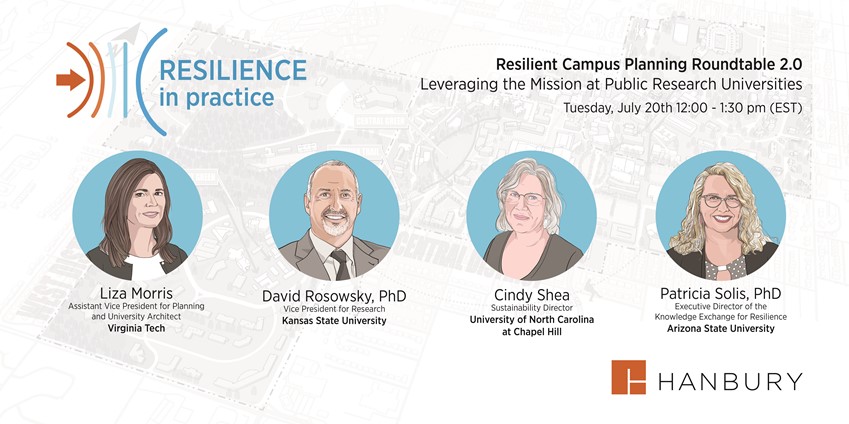Resilience in Practice: resilient campus planning 1.2
Hanbury recently held the first roundtable of a three-part series, Resilience in Practice | resilient campus planning, focused on the unique issues and opportunities faced by small, private, liberal arts colleges. Our previous two recaps relayed lessons learned from the experiences, stressors, and strategies our panelists have employed on their campuses. Here we extend the conversation to what our panelists are seeing on the horizon. Capitalizing on small colleges’ flexibility, nimbleness, and capacity for change, panelists posed questions about the future of the college experience:
The Importance of Place
- What is the role of the college campus?
- How does the physical campus define the student experience?
- In what ways might the physical campus change or stay the same?
“One of the things that brings students to Middlebury is its place… In the fall we heard a lot of students say how glad they were to be back in the Green Mountains during foliage… [The Knoll] is our farm, garden, food, education, and play space center… we’ve built [it] around the idea of sustainability of self and of place. It is both a place to learn… and a bit of a refuge… We found this fall, when students were locked down considerably and confined to campus, that this space was overwhelmed with demand for use.”
— Jack Byrne | Dean of Sustainability and Environmental Affairs | Middlebury College
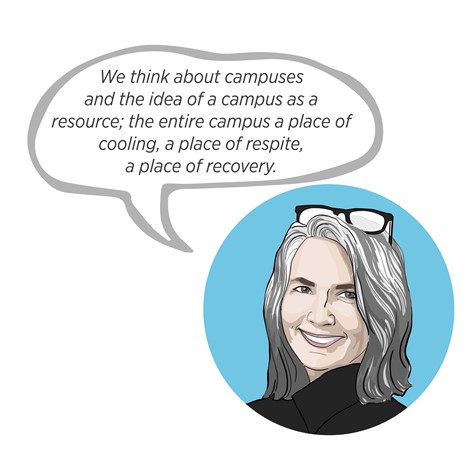
“As we look at climate change, particularly in the south, we are expecting a significant species shift…so [if] we think about campuses and the idea of a campus as really a resource; the entire campus a place of cooling, a place of respite, a place of recovery in very trying times; not only the students, faculty, and staff are there, but the community seeing that as a place of respite… with these climate projections and the likelihood of these species shifts, not only the trees and other floras but also the vector borne illnesses that come with this kind of species shift… The outdoor strategy will have to carry as much weight as the indoor strategy.”
— Dr. Janice Barnes, AIA | Founder of Climate Adaptation Partners
“Even as higher education folks have become more adept communicating in the virtual environment, we've seen an increase in the desire and need to be together, to have that personal connection...those types of spaces are becoming even more important on campus. Both indoor and taking advantage of the outdoors.”
— Keith Storms | President, Principal, Planner | Hanbury
The Resilient Student
- What do students and their families look for in a college experience?
- How are students prepared for the job market and life beyond the university?
- How can the idea of the “typical student” change?
“There are billions slated for stimulus around climate change. To what extent have those projected programs been considered within the institutions' existing education offerings? What might those introduce in terms of opportunities particularly for rapidly tracking those who might be more vulnerable now into good paying jobs that are doing the right things for the overall climate and economy?”
— Dr. Janice Barnes, AIA | Founder of Climate Adaptation Partners
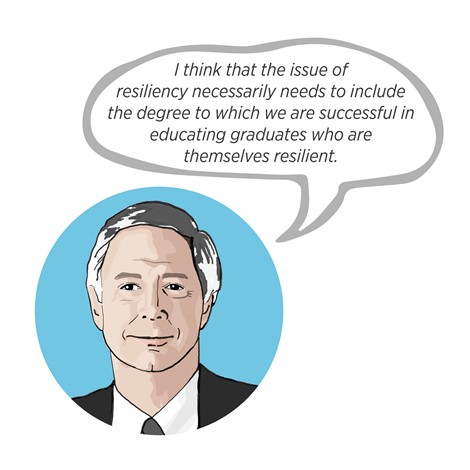
“I think that the issue of resiliency necessarily needs to include the degree to which we are successful in educating graduates who are themselves resilient. Yes, it is important for your physical plan and for your financial planning and so much else to contribute to institutional resilience, but we will have been less than fully successful in as a result of success in all of those things, if our graduates still leave… less independent than they ought to be… as graduates.”
— Dr. John McCardell, Jr. | Vice-Chancellor Emeritus | Sewanee: The University of the South
“I grew up in rural Appalachia, I recognize how difficult it is to get decent internet access with those hills. So it is an important piece to remember those who would like the opportunity to either further their education or to start their education but who may be hampered by the inability to get to online access… and to be an advocate with your government to try to improve that situation.”
— Dr. Janice Barnes, AIA | Founder of Climate Adaptation Partners
The Structure of Learning
- How can the methods of teaching prioritize student and teacher wellbeing?
- What will the process of earning a degree look like in 10, 20 years?
- How can a change in structure redefine how we use space and buildings on campus?
“What I really hope will continue to happen is a reconsideration of the best ways of teaching what we teach and of allowing ourselves to think more imaginatively about everything; from how we organize the day, to the week, to the semester, to what is magical about 4 years.”
— Dr. John McCardell, Jr. | Vice-Chancellor Emeritus | Sewanee: The University of the South
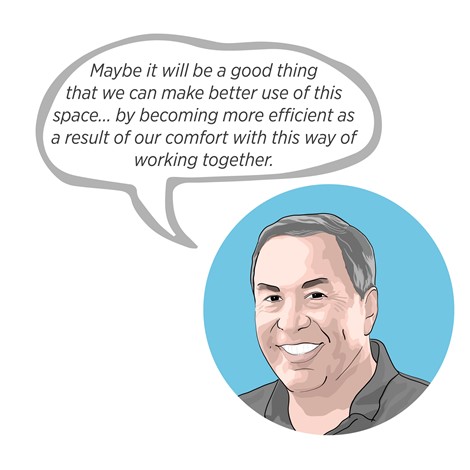
"We are trying to figure out what the implications are for staff who traditionally have private offices and show up for work every day from 9-5. Could a schedule of a few days on and a few days off campus be just as or more effective in some ways? What are the implications for the premium on office space? Maybe it will be a good thing that we can make better use of this space and not have to build another building, by becoming more efficient as a result of our comfort with this new way of working together."
— Jack Byrne | Dean of Sustainability and Environmental Affairs | Middlebury College
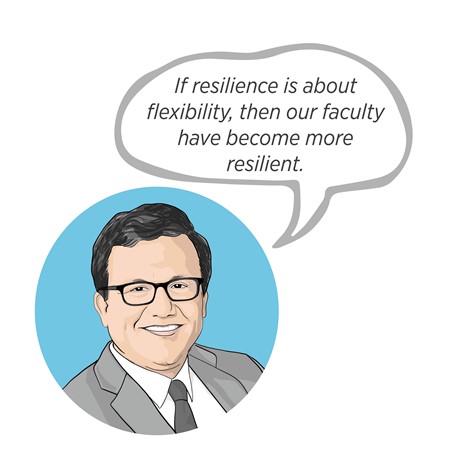
“If resilience is about flexibility, then our faculty have become more resilient. And a lot of questions are open. When our students have cocurricular activities or are working one or two jobs. You start to think about that and think about all the demands on their time and organizing classes so that most of them start at 10 in the morning… probably not ideal for the student population. So, we are starting to think about whether some targeted online classes might still happen. I don’t think any of our students want all of their classes online, but under certain circumstances it might start to make a lot of sense.”
— Dr. John Swallow | President | Carthage College
The questions above illustrate that resilience planning is a continual process of re-evaluation, re-alignment, and strategic action. Building “boundary buddies” across disciplines and having thoughtful, engaged conversations from a holistic perspective leads to more informed decision making and planning.
Our next group of roundtable panelists represents large, public research universities from around the country. We hope you will join us on July 20 from 12:00-1:30 pm (EST) to hear a new set of panelists discuss large-scale resilience planning, partnership development, and regional impact. Listed below are the moderators and panelists for the Resilient Campus Planning | Leveraging the Mission at Public Research Universities roundtable:
Session Moderators
- Dr. Janice Barnes, AIA | Founder of Climate Adaptation Partners
- Scott Miller, LEED AP | Principal, Planner | Hanbury
Session Panelists
- Liza Morris | Assistant Vice President for Planning and University Architect | Virginia Tech
- Dr. David Rosowsky | Vice President for Research | Kansas State University
- Cindy Shea, LEED AP | Sustainability Director | University of North Carolina at Chapel Hill
- Dr. Patricia Solis | Executive Director of the Knowledge Exchange for Resilience | Arizona State University
Register to attend this FREE event HERE.
